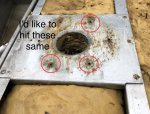Hello everyone,
I’m replacing a rotted floor/deck/sole on my 16’ Sea Nymph fishing boat (1986, freshwater). I’ve learned a lot on these forums already and taken so much of the advice.
I'm now wondering if there’s a cool technique to find the original holes in the Aluminum supports for my seat mount?
I can redrill into the support tabs for the floor and if I happen to barely miss a hole and blow out that hole, no problem. I’ll just remove that screw, move over and inch and redrill. But because the seat mount is “keyed” for the seat post I’d like to keep the same orientation and rotation and therefore use the same holes. The danger is being <1 hole diameter off and “blowing out” that hole. Then I’m “screwed”. Ha.
so How does one find little blind holes on the other side of new plywood? If I were super accurate at measuring and cutting and fitting I could find them theoretically. Or if this was some CNC set up I’m sure it could be calculated and be repeatable, but I don’t trust that I can get anywhere near that level of precision.
I’m replacing a rotted floor/deck/sole on my 16’ Sea Nymph fishing boat (1986, freshwater). I’ve learned a lot on these forums already and taken so much of the advice.
I'm now wondering if there’s a cool technique to find the original holes in the Aluminum supports for my seat mount?
I can redrill into the support tabs for the floor and if I happen to barely miss a hole and blow out that hole, no problem. I’ll just remove that screw, move over and inch and redrill. But because the seat mount is “keyed” for the seat post I’d like to keep the same orientation and rotation and therefore use the same holes. The danger is being <1 hole diameter off and “blowing out” that hole. Then I’m “screwed”. Ha.
so How does one find little blind holes on the other side of new plywood? If I were super accurate at measuring and cutting and fitting I could find them theoretically. Or if this was some CNC set up I’m sure it could be calculated and be repeatable, but I don’t trust that I can get anywhere near that level of precision.





















